The Fitness Zone

Common Running Injuries and How to Fix Them
To help clients run without pain and injury, it is critical that the major areas and muscles that control stress to the body when running are functioning optimally. Corrective exercise specialist Justin Price looks at the exercises to help achieve this.
Running is one of the most popular forms of exercise around the world. It is also an activity associated with a high risk of injury, with almost half of all runners reporting an injury at least once a year (Messier et al, 2008). Most running injuries are typically found in the lower body, with up to 80% of all injuries occurring in the lower extremities (Van Gent et al, 2007). The four lower-body injuries runners experience most often are plantar fasciitis, Achilles tendinitis, patellofemoral syndrome (i.e. ‘Runner’s Knee’) and IT band syndrome (Hespanhol et al, 2011). These common injuries occur as a result of muscle and movement imbalances compounded by overuse (Messier et al, 2008).
Understanding common running injuries
Let’s take a closer look at the four most commonly diagnosed running injuries.
Plantar fasciitis
This condition is characterised by pain in the heel and bottom of the foot. The word ‘plantar’ refers to the underside of the foot and ‘fascia’ is the term for the connective tissue that wraps around muscles, tendons and ligaments (see Figure 1). The suffix ‘-itis’ is medical terminology for inflammation. Therefore, ‘plantar fasciitis’ refers to inflammation or irritation of the band of connective tissue located on the underside of the foot called the plantar fascia (Price, 2014).
Figure 1. The foot, showing plantar fascia
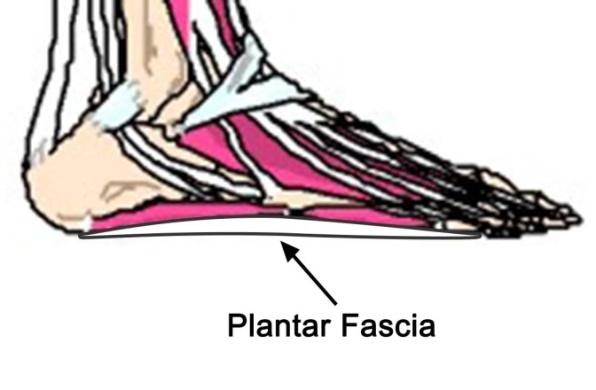
Achilles tendinitis
This condition is characterised by pain on the back of the lower leg, near the heel. The Achilles tendon attaches the muscles of the calf (i.e. soleus and gastrocnemius) to the heel bone (i.e. calcaneus) (see Figure 2). Inflammation of this tendon is called ‘Achilles tendinitis’ (Waldman, 2009).
Figure 2. The calf and heel, showing Achilles tendon
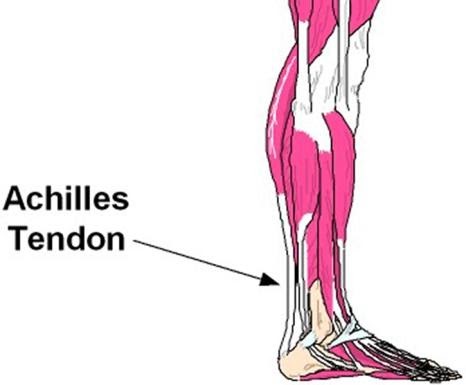
Patellofemoral pain syndrome
This condition is characterised by pain at the front of the knee, near or under the kneecap. The kneecap is a small bone that glides over the notch at the bottom of the thigh bone (i.e. the femoral groove) as the knee bends and straightens (see Figure 3). The word ‘patello’ refers to the kneecap (i.e. patella) and ‘femoral’ refers to the thigh bone (i.e. femur). Therefore, inflammation/irritation and pain associated with most problems in this area at the front of the knee is called ‘patellofemoral pain syndrome’ (Thomeé, Augustsson and Karlsson, 1999).
Figure 3. The knee joint, showing patella and femoral groove
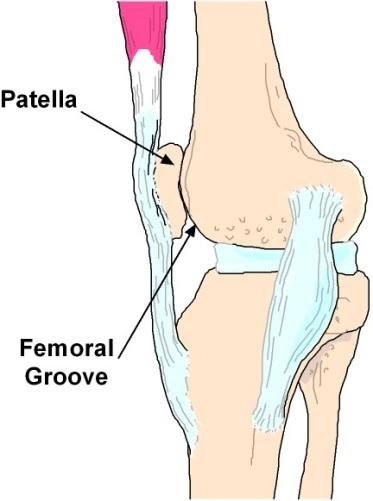
Iliotibial band syndrome
This condition is characterised by pain on the outside of the knee (and sometimes the side of the hip). The iliotibial band (i.e. IT band) is a strong connective tissue that runs down the side of the leg from the side of the pelvis to the outside of the shin (see Figure 4). It attaches the gluteus maximus and tensor fascia latae muscles to the lower leg (i.e. the outside of the tibia). ‘Illio’ refers to the ilium bone of the pelvis and ‘tibial’ refers to the tibia (i.e. the large shin bone). Therefore, irritation to this structure is called ‘iliotibial band syndrome’ (Frontera, Silver and Rizzo, 2015).
Figure 4. The iliotibial band runs down the side of the leg

Muscle dysfunction is a major cause of most running injuries
If your muscles are not healthy, flexible and strong they become less effective in transferring weight and absorbing shock. As a result, other soft tissues in the body like fascia, tendons, ligaments and joints end up experiencing more stress than they should. Over time, these structures become strained, leading to injury, pain and further dysfunction. That is why common running injuries (i.e. plantar fasciitis, Achilles tendinitis, patellofemoral pain syndrome and IT band syndrome) manifest in connective tissue and joints.
Therefore, if you want to help clients run without pain and with minimized potential for injury, it is critical that the major areas (and associated muscles) that control stress to the body when running (i.e. feet, ankles, hips) are functioning optimally (Price, 2018; Price and Bratcher, 2019).
Corrective exercises for running
As with any corrective exercise program, utilise self-myofascial release techniques first to recondition and rejuvenate those soft tissue structures you plan to address. Progress to gentle, isolated stretching techniques (that help retrain joint mechanics) before advancing to more dynamic, integrated strengthening techniques that help improve movements in the areas being targeted.
Foot and ankle exercises
Use a foam roller, tennis ball or similar self-myofascial release tool to massage these muscles to help improve their capacity to contract, lengthen and relax effectively during running. Then, progress to the following stretching exercise, which is designed to gradually introduce movement to the ankle.
Foot and ankle stretch
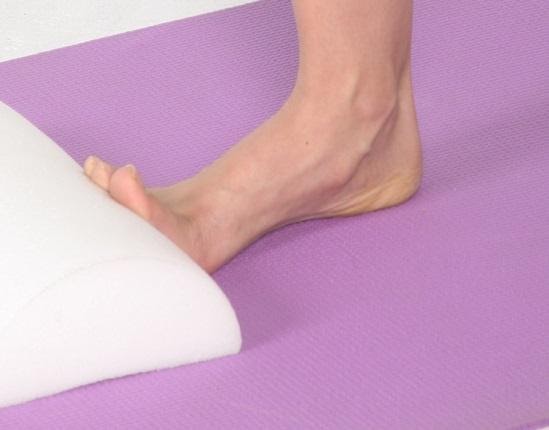
Place the toes of one foot up against the base of a wall or half foam roller. Gently bend the ankle forward and rotate it toward the midline of the body. Make sure the outside of the foot, ball of the foot or heel do not come off the ground during the movement. Return to the start position. Perform 8 to 10 repetitions each side.
Heel to toe rocking
Once foot and ankle mobility has been improved with the controlled stretch detailed above, introduce dynamic activities that rotate, and strengthen, the foot and ankle.
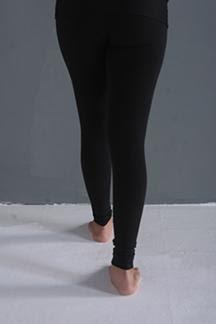
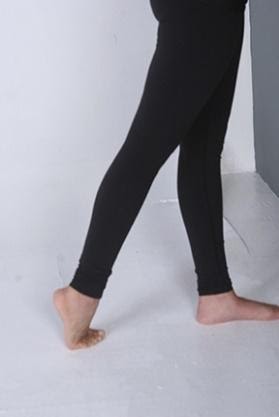
Stand in a staggered stance with the right foot back and hands placed on a wall in front of you for balance. Keep both feet pointing forward as you transfer your weight forward into the left leg, while raising the right heel up and rolling/rotating the right ankle out. Keep the toes of the right foot in contact with the ground throughout the movement. Lower the right heel back to the ground as you let the right ankle roll inward and the foot flatten. Repeat exercise, rotating the ankle ‘up and out’ and ‘down and in’, slowly increasing your speed. Perform 10–15 repetitions each side.
Hip exercises
The major muscles that control rotation of the hip are inherently linked to the torso, as they all come together on the pelvis (i.e. gluteus maximus, hip-flexors, hamstrings, adductors, obliques and latissimus dorsi). Therefore, exercises designed to improve movement and strengthen muscles of the hips should be addressed in conjunction with movements of the torso. Use a foam roller to massage the major muscles of the hips and trunk prior to progressing to the stretching techniques outlined below.
Glute stretch (with rotation)
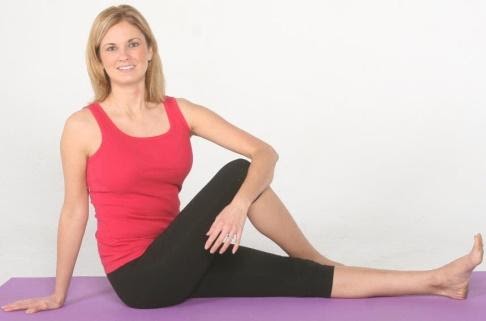
Sit on the floor with one leg straight. Bend the other leg and cross it over the straight leg and place it on the floor at knee height. Pull the bent knee towards your chest as you rotate over the bent leg to stretch the glutes and muscles that wrap around the torso. Hold for approximately 30 seconds on each side.
Hip-flexor stretch (with rotation)

Kneel on one knee with left foot forward. Tilt pelvis under and align your pelvis from left to right. Rotate your torso over your left leg. Do not let the pelvis move as you rotate. Hold stretched position for 2-3 seconds. Return to start and repeat. Perform a total of 6-8 repetitions on each side.
Hamstring stretch (with rotation)
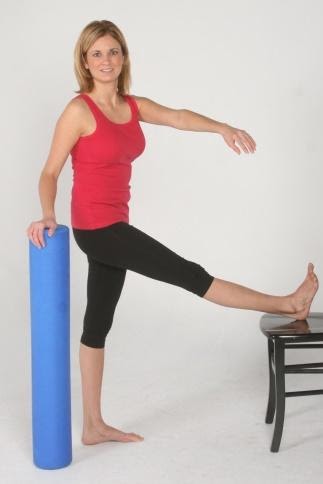
Place your right leg up on a bench or chair. Keep leg straight and both feet aligned facing forward. Align your pelvis left to right and keep your hips ‘stacked’ evenly over your legs and feet. Rotate your torso over your right leg without bending your spine to the side. Hold stretched position for 2-3 seconds. Return to start and repeat. Perform a total of 6-8 repetitions on each leg.
Adductor stretch (with rotation)
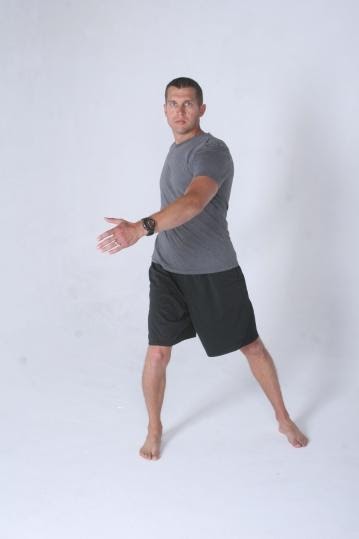
Stand with feet about two feet apart. Gently bend your right knee as you transfer your weight into your right leg and rotate your torso over your right hip. Keep the left leg and foot straight and in contact with the ground. Hold stretched position for 2-3 seconds. Return to start and repeat. Perform a total of 6-8 repetitions on each leg.
Progress to the following integrated strengthening techniques to improve the ability of the hips and torso to rotate together at real speed (i.e. mimicking running movements).
Hips and torso stretch (with rotation)
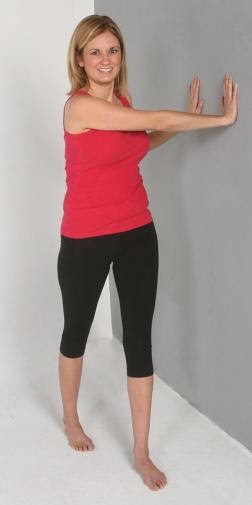
Stand in a split step about 45cm away from a wall, with the foot closest to the wall facing forward. Keep your head facing forward and straight, and rotate your torso toward the wall, placing your hands on the wall to help you rotate further. As you rotate, ensure your pelvis stays perpendicular to the wall (i.e. do not let your hips move forward, backward or to the side) and that your shoulders stay level (i.e. you do not lean to the side). Once the movement can be performed correctly (without moving the hips or side bending), increase the speed with which you perform the rotation. Perform 10 to 15 repetitions on each side.
Lunge (with rotation)
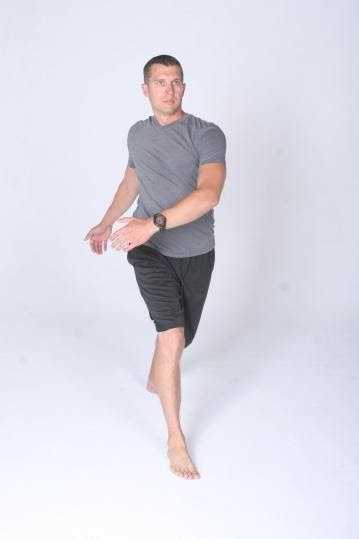
Lunge forward with your right leg as you swing your arms and rotate your torso to the right. Keep your feet facing forward and your torso upright (i.e. do not lean forward or to the side). Return to start position and repeat. Perform for 8-10 repetitions each side.
Become the go-to fitness professional for sports-related injuries
While running with all parts of the body working correctly helps improve health and function, muscle and movement imbalances (if left untreated) can make running a painful and frustrating experience. Addressing your client’s weakness and dysfunction can help not only decrease their potential for pain, but increase your reputation as the go-to fitness professional for fixing sports-related injuries.
Learn more about corrective exercise with The BioMechanics Method® Corrective Exercise Specialist (TBMM-CES) course available through Australian Fitness Network.
References
Frontera, W., Silver, J. and Rizzo, T. 2015. Essentials of physical medicine and rehabilitation: musculoskeletal disorders, pain and rehabilitation. (3rd edition). Philadelphia: Saunders Elsevier.
Hespanhol, L. C., Carvalbo, A.C.A., Costa, L.O.P and Lopes, A.D. 2011. The prevalence of musculoskeletal injuries in runners: a systematic review. British Journal of sports medicine. 45:351-352
Messier, S. P., Legault, C., Schoenlank, C.R., Newman, J.J., Martin, D.F. and DeVita, P. 2008. Risk factors and mechanisms of knee injury in runners. Medicine and Science in Sports and Exercise. 40(11):1873.
Price, J. and Bratcher, M. 2019. The BioMechanics Method Corrective Exercise Specialist Education Program (2nd ed). San Diego, CA: The BioMechanics Press.
Price, 2018. The BioMechanics Method for Corrective Exercise. Champaign, IL: Human Kinetics
Price, J. 2014. Understanding and alleviating plantar fasciitis. ACE ProSorce Magazine. The American Council on Exercise. Retrieved from www.acefitness.org on 10/11/2016. https://www.acefitness.org/prosourcearticle/3766/understanding-and-alleviating-plantar
Thomeé, R., Augustsson, J. and Karlsson, J. 1999. Patellofemoral pain syndrome: A review of current issues. Sports Medecine. Oct; 28 (4): 245-262.
Waldman, S. 2009. Pain review. Philadelphia: Saunders Elsevier.
Van Gent, R.N., Siem, D., Van Middelkoop, M., Van Os, A.G., Bierma-Zeinstra, S.M. and Koes, B.W. 2007. Incidence and determinants of lower extremity running injuries in long distance runners: A systematic review. British Journal of sports medicine. 41(8):469.
Read more articles
Disclaimer: Where Certificate III in Fitness, Cert III/Cert 3, or Fitness Coach is mentioned, it refers to SIS30321 Certificate III in Fitness. Where Certificate IV in Fitness, Cert IV/Cert 4, or Personal Trainer is mentioned, it refers to SIS40221 Certificate IV in Fitness. Where Master Trainer Program™ is mentioned, it refers to Fitness Essentials and SIS40221 Certificate IV in Fitness. Where Master Trainer Plus+ Program™ is mentioned, it refers to SIS30321 Certificate III in Fitness and SIS40221 Certificate IV in Fitness. Where Certificate IV in Massage or Cert IV/Cert 4 is mentioned, it refers to HLT42021 Certificate IV in Massage Therapy. Where Diploma of Remedial Massage is mentioned, it refers to HLT52021 Diploma of Remedial Massage.











